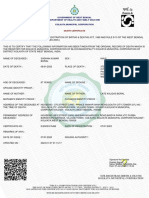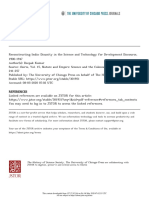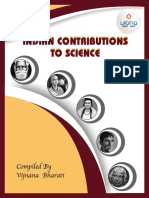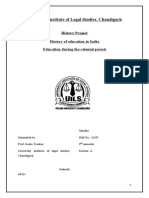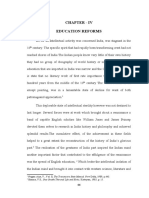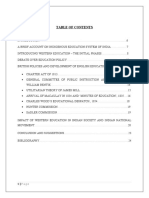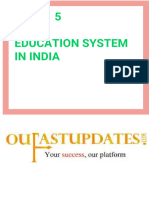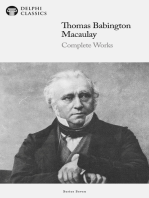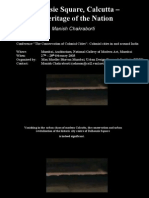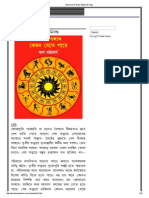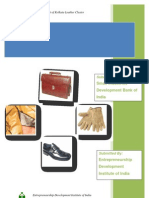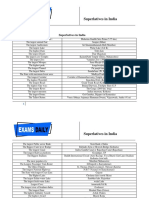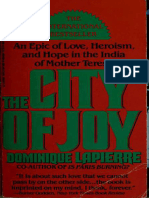01 Editorial
01 Editorial
Uploaded by
shivam shelkeCopyright:
Available Formats
01 Editorial
01 Editorial
Uploaded by
shivam shelkeCopyright
Available Formats
Share this document
Did you find this document useful?
Is this content inappropriate?
Copyright:
Available Formats
01 Editorial
01 Editorial
Uploaded by
shivam shelkeCopyright:
Available Formats
DOI: https://doi.org/10.36094/sc.v89.2023.Science_Education_in_India.Tripathi.
293
SCIENCE AND CULTURE
VOLUME 89 SEPTEMBER-OCTOBER 2023 NOS. 9–10
E DITORIAL
SCIENCE EDUCATION IN INDIA
T
he British took many college in Calcutta (1835). Scientific equipments started
steps on education and arriving in 1823 and science teaching was initiated.
entertainment in order Raja Ram Mohan Roy was the torch bearer for Indian
to rule the country Renaissance followed by Iswar Channdra Vidyasagar,
effectively. Calcutta, being Michael Madhusudan Datta, Bankim Chandra
the capital of India from 1772 Chattopadhyay, Rabindranath Tagore, Prafulla Chandra Ray,
to 1912, was somewhat Swami Vivekananda, Asutosh Mookerjee, Rajendralal Mitra,
privileged in terms of Nazrul Islam, and many others from all stages of Indian
education, development of life, culture, religion, literature and finally science. They
infrastructure and many are the jewel of late 19th to 20th centuries. The other
other aspects. These celebrated personalities were also playing significant role
pioneering gestures include for the greater development of the academic scenario of
the first newspaper (The Bengal Gazette) printed in Calcutta India i.e. Pramatha Nath Bose - pioneering Indian Geologist,
in 1780, the first Madrasa School in 1780, the first official Satyajit Ray - Author, Calligrapher and Film Director,
newspaper (The Calcutta Gazette) established in 1784, Documentary Filmmaker, Magazine Editor, Satyendranath
“The Asiatik Society” ( the first academic institution in Tagore- the first Indian civil servant and social reformer.
India, 1784) for “Oriental research”, the first Bengali Bengal has been on the forefront of evolving, shaping
magazine ‘Digdarsan’ published from Serampore (1818), the and enriching Indian culture in all its dimensions including
Hindu college ( Presidency college) in 1817, the Calcutta science. Bengal has been the unique land with rich heritage
University in 1857, the Indian Museum in 1875, and the of literature, philosophy, science and religion which shaped
leading English Newspaper ‘The Statesman’in 1875. Finally, Indian civilization. Bengal is the territory of great
the first science research laboratory of the country (Indian scientists like Acharya J. C. Bose, Acharya P.C. Ray, C.V.
Association for the Cultivation of Science) was established Raman, S. N. Bose, Meghnad Saha, and P.C. Mahalanobis
in 1876 in Calcutta. All these helped in the enlightenment who made signal contribution to the field of science.
of the people of the country. Rabindranath Tagore earned a coveted place in the hearts
and minds of all Indians through his original contribution
The period 1813-35 is very important for India’s
in literature. “Bande Mataram” written by Bankim Chandra
growth academically. In 1813 the East India Company
Chattopadhyay became our national song revealing the
acquired an education policy whereby it was sanctioned
nationalistic spirit across the length and breadth of India.
an amount one Lakh rupees on education for the first Besides, personalities of extraordinary dedication and
time. It was a phase of the transition from the Moonshee accomplishment like Satyajit Ray, Mother Teresa, Amartya
to the Baboo having the full and active support of the Sen and Abhijit Banerjee, who are revered throughout the
native leadership. The oriental colleges were slowly world. Asima Chatterjee and Archana Sharma had been
angilicised. Unani and Ayurvedic classes were added the role model as women scientists who have also made a
(1827) to the Madrasa and the Sanskrit College, which mark in the global map in their field of research and
then made way (1835) for a full-fledged (western) medical teaching.
VOL. 89, NOS. 9–10 293
The present system of education in India was cannot be removed by to the neglect of science. Physics,
introduced in the early years of 19th century. A major Chemistry, Botany, Agriculture and Meteorology should
benefit to Indian science during British rule was the spread be properly studied here. Along with these Physiology
of education in English, the language of modern science. and Hygiene should be studied under the guidance of a
The learning of science got a fillip in 1857 when three physician and acquaintance made with machinery with the
universities were created in India i.e. Calcutta, Madras help of a trained mechanic.
and Bombay. The Universities of Punjab and Allahabad The nation is always grateful to Asutosh Mookerjee
were also created later on. All of these universities had for initiating modern science education in India.
been modeled after the University of London and all of Rabindranath had a very good bonding with Asutosh
them were examining universities and not teaching regarding the academic development of our country. He
universities. At this stage Sir Asutosh Mookerjee had a wide and diverse interest in science. Asutosh
introduced his momentous reforms in the University of Mookerjee, the then Vice- Chancellor of the University of
Calcutta. He started creating the post-graduate department Calcutta find out a galaxy of Indian scientists, who
in all subjects and also teaching was concentrated in the showed their talents and made immense contributions
university which ultimately resulted in transforming an towards the development of a global profile of Indian
examining university into a teaching university of the science. The development of post graduate teaching and
highest type. In 1876 a rich physician, Dr. Mahendra Lal research in science and technology at the University of
Sircar, set up the first scientific research institution in Calcutta opened a door for the Indians to learn science.
Calcutta, known as the Indian Association for the Dr. Mahendra Lal Sarkar was the first person to initiate
Cultivation of Science, which became the focus of the science movements in India. This was simply possible
scientific activities in pre-independence India. Then only due to the contribution of educationists, scientists and
the foundations for basic science were expanded and scientific workers in India. The Indian research institutes
academic science in the universities received great like Indian Association for the Cultivation of Science in
attention. Calcutta (in 1876), Tata Institute (1908) now known as
Indian Institute of Science in Bangalore and the Bose
Education, primary, secondary and higher, must gain
Institute (1917) in Calcutta are landmarks in science
top priority if our illiteracy in many dimensions is to be
development but none can reach that level before
abolished. Education is a birth-right, a constitutional independence as compared to the developments initiated
mandate. After 76 years of independence, as a nation, by Asutosh Mookerjee at the University of Calcutta.
India still lag in literacy and even in the field of primary
education. In 21st century India is witnessing changes in Finally, let us recall Gurudev Rabindranath Tagore’s
almost all areas of human endeavour. Education is also message about the real destination of our education: “The
universally recognised as a form of investment in human highest education is that which merely give us
beings which yields economic benefits and contributes to information but makes our life in harmony with all
a country’s future wealth by increasing the productive existence”. Education sharpens the intellect of the pupil
capacity of its people. The key resources for any society and enables him to acquire mastery over the fundamentals
of nature and science and thereby enables him to
are its people. Education is a dialogue between the past,
understand his relationship with the world at large.
present and the future, so that the coming generations
generating new knowledge and new entities. Science
receive the accumulated lessons of the heritage and
education is the teaching and learning of science to
scientific attributes to carry forward. For All-round
school children, college students, or adults within the
education, there must be a blending of Science with
general public. Science education cultivates students’
Humanities.
curiosity about the world and enhances scientific attitude
Rabindranath welcomed the West because it had and thinking. It provides knowledge of the facts,
brought the gift of Science: “Let admit that modern science principles, concepts and laws of science, besides
is Europe’s great gift to humanity for all time to come. developing skills in experimentation, observation and also
We, Indian, must claim it from her hands, and gratefully critical thinking, problem solving and information literacy.
accept it in order to be saved from the curse of futility by Science education includes science centers, science
lagging behind. We shall fail to reap the harvest of the museums and digital learning environments.
present age if we delay”. One thing is certain that the all- A new era was opened in the history of science in
embracing poverty which has overwhelmed our country India when the country became independent on August
294 SCIENCE AND CULTURE, SEPTEMBER-OCTOBER, 2023
15, 1947. There was a remarkable
expansion of facilities for scientists
and the research began and prospered
in many fields. India is now a member
of (i) the Nuclear club, (ii) the Space
club, and (iii) the Antarctica
exploration club. It has the world’s
third largest pool of trained
technologists, next only to the USA
and the Soviet Union, though it is still
a developing nation. Now it is the role
of Indian scientists including the
women members to do much more to
catch up with the advanced countries.
Modern India has had a strong
focus on science and technology,
realizing that it is the key element of
economic growth. Science is at the core of our efforts The President also pointed out that our daughters
towards socio-economic transformations, said Prime perform better when given the opportunity. She also noted
Minister Narendra Modi while inaugurating Vaishvik that the participation of girls in technology institutions is
Bharatiya Vaigyanik (VAIBHAV) Summit. “The need of also increasing. She said that efforts must be made to
the hour is to ensure more youngsters develop an interest promote the presence and excellence of female students in
in science. For that, we must get well-versed with the Science, Technology, Engineering and Mathematics
science of history and the history of science,” said the (STEM).
Prime Minister. While addressing the researchers and The President also said that “knowledge centres
academicians via an online conference, PM said, “India’s should become hubs of the knowledge economy. They
call of an Atmanirbhar Bharat (self-reliant India), should move forward with the ambition of developing
includes a vision of global welfare. In order to realize cutting-edge technologies. She added that our Technology
this dream, I invite you all and seek your support.” Talking Institutes have to take the initiative in areas like artificial
about the National Education Policy (NEP) the Prime intelligence”. The President said that the younger
Minister said, NEP aims to “boost curiosity governed generation see their role models in their teachers and
science and gives a much-needed boost to research and successful personalities. The ideals and examples set by
Science”. He said that it will give special focus to them through their conduct are very important. She finally
interdisciplinary science. stressed that the character-building of youth should be
given priority in higher–learning institutions. Morally
The President of India, Her Excellency Smt Droupadi
strong youth, educated in modern knowledge-science and
Murmu, inaugurating the Visitor’s Conference 2023 at technology would build a better society and nation.
Rashtrapati Bhavan on 10 July 2023 categorically mentioned
that education is vital for the progress of the individual, This special issue of the Journal Science and Culture
society and country. She stated that providing equitable reflects the type of research work carried out by our faculty
and inclusive higher education to youth from socially members and I am delighted to announce that this issue
and economically disadvantaged groups is one of the is a symbol of celebration of the 15th Foundation Day of
National Education Policy- 2020 priorities. She stated the Central University of Odisha, Koraput (29th August,
2023).
that the NEP aims to make India a Global Knowledge
superpower. She expressed confidence that higher Professor (Dr.) Chakradhar Tripathi
educational institutions will play an essential role in Vice-Chancellor
achieving the goal of establishing India as a developed Central University of Odisha
nation by the year 2047. E-mail: vc@cuo.ac.in
VOL. 89, NOS. 9–10 295
Prof. (Dr.) Chakradhar Tripathi
A distinguished educationist, Prof. Chakradhar Tripathi assumed office as the
Vice- Chancellor of Central University of Odisha on 26 September 2022 at the
University campus, Sunabeda. Her Excellency, Smt. Droupadi Murmu, the
President of India, in the capacity as the Visitor has appointed Prof. Chakradhar
Tripathi as the Vice-Chancellor of the Central University of Odisha, Koraput
(CUO) as per Statute 2(1) of the Central Universities Act, 2009 for a term of (5)
five years from the date of his joining or till he attains the age of seventy
years, whichever is earlier, as per the communiqué received from the Ministry
of Education, Govt. of India on 13 September 2022. Prof. Tripathi is the fourth
regular Vice-Chancellor of the University.
Prior to joining the CUO, Prof. Tripathi was the Senior Professor, Department of Hindi, Visva-Bharati,
Santiniketan, West Bengal. His area of Specialization is Medieval and Modern Hindi Poetry. Prof. Tripathi has
thirty three years of impressive academic as well as administrative experiences in various capacities including
Director, Physical Education, Sports, National Services and Student Welfare; Coordinator, International
Collaboration (following NEP-2020); Head, Department of Hindi; Chairman, Board of Studies in Hindi; Director
(Honorary), Centre for Hindi Teaching, Tagore Institute of Art & Education; President, Visva-Bharati, Shaikshik
Sangh.
He served as a nominee of the President of India in various Statutory Committees, Advisory Committees
and Selection Committees including Vice-Chancellor of national Higher Educational Institutions and Universities.
He is the recipient of many awards including Silver Medal Awards from Hindi Vidyapeeth, Deoghar, Bihar in
Sahitya Bhushaw Exam; Hindi Sevi Samman award from Visva-Mukti, KIIT, Bhubaneswar ; Bhasha-SetuSamman
award from Mahavidya, B. Deoghar; Shikshak Samman award from Gahmar Welfare Society, Gahmar, U.P.;
Surya Antarbharati Bhasha Samman award from Surya Sansthan, Noida, Delhi; Hindi Sevi Samman award from
Bihar Rashtra Bhasha Parisad, Patna; Sri Ganesh Ballabhjee Rathi Memorial Award from Sahitya Mandal,
Shrinathdwara, Rajasthan and Pandit Vidyashankar Pandey Sahitya Vibhushan Samman, 2020 award from
Munishwandutta P.G. College, Pratapgarh, U.P. He is a prestigious member of Raja Rammohan Roy Library
Foundation, Kolkata, Ministry of Culture, Govt. of India.
Born in 1960 in the village Jagannathpur, Basantia, Mareigaon under Hatadihi block of Kendujhar district,
Odisha, renowned scholar, Prof. Tripathi did his M.A. & Ph.D. in Hindi from VisvaBharati and Graduation from
Utkal University. He has published over six books including Kabir Ki Bhakti, Siyaram Tiwari: Vyaktitwa
EvamKrititva, Nayee Kavitaka Pratipadya, Chintamani Sanchayan, Krishan Chander Ki Pratinidhi Kahaniyan,
Atmanirbhar Bharat (Bengali Version). He has also four edited books and Five translated books. His research
papers are published in reputed national and international Journals. He has supervised more than 17 scholars
for award of Ph.D. and havecompleted few research projects.
Prof. Tripathi is known to have taken the initiative to advocate the ideologies of Utkalmani Gopabandhu
Das. The translation of ‘Gopabandhu Rachnabali’(Total–08 volumes) is being published under the guidance
and Chief editorship of Prof. Tripathi by NBT.
Recently, Prof. Chakradhar Tripathi was felicitated and awarded the prestigious Acharya Shivpujan Sahay
Smriti Samman for his valuable contribution towards the promotion of the Hindi Language and Literature by
His Excellency the Governor of Bihar, Shri Rajendra Vishwanath Arlekar on the occasion of the 42nd Convention
of Bihar Hindi Sahitya Sammelan held at Patna on 6th May 2023 in the presence of the Chairman of the
Conference, Dr. Anil Sulabh and other dignitaries.
Note by the Editor-in-Chief, Science and Culture: This issue has been sponsored by the Central
University of Odisha, Koraput.
296 SCIENCE AND CULTURE, SEPTEMBER-OCTOBER, 2023
You might also like
- DeathCertificate 2689185Document1 pageDeathCertificate 2689185Sudan Shaw100% (3)
- Durga Puja of "Bonedi" Families at KolkataDocument44 pagesDurga Puja of "Bonedi" Families at KolkataS_Dasgupta100% (1)
- Sketches of Science Popularization Movements in Pre and Post Independent IndiaDocument13 pagesSketches of Science Popularization Movements in Pre and Post Independent IndiaARGHA MANNANo ratings yet
- Trends of Educational Development in Colonial Odisha From 1866 To 1947: A RetrospectiveDocument3 pagesTrends of Educational Development in Colonial Odisha From 1866 To 1947: A RetrospectiveManas BeckNo ratings yet
- Unit-5: Education System in India: Essence of Indian Traditional KnowledgeDocument25 pagesUnit-5: Education System in India: Essence of Indian Traditional Knowledgedeccancollege100% (2)
- Itcs-Ch 5Document7 pagesItcs-Ch 5The OneNo ratings yet
- 1 PBDocument16 pages1 PBabhinavmahan2002No ratings yet
- History of Indian EducationDocument8 pagesHistory of Indian Educationआनंद गुप्ताNo ratings yet
- India-Education System: Indian Education Before British ColonizationDocument3 pagesIndia-Education System: Indian Education Before British ColonizationМария РыжковаNo ratings yet
- Good PDFDocument18 pagesGood PDFshiv guptaNo ratings yet
- ICS VVM Full With Final Cover Page 2pdfDocument97 pagesICS VVM Full With Final Cover Page 2pdfHemanth HemuNo ratings yet
- Education of Science During Medieval Bengal A Historical PerspectiveDocument5 pagesEducation of Science During Medieval Bengal A Historical PerspectiveEditor IJTSRDNo ratings yet
- 12 - 46 49 Dr. Rajshree N. Pandya PDFDocument4 pages12 - 46 49 Dr. Rajshree N. Pandya PDFAdhisilabhikkhuNo ratings yet
- Chapter 1Document13 pagesChapter 1AkxzNo ratings yet
- Indian EducationDocument1 pageIndian EducationAnurag GoelNo ratings yet
- India's Contribution To The Rest of The WorldDocument62 pagesIndia's Contribution To The Rest of The Worldraj06740No ratings yet
- Social Science Research in IndiaDocument6 pagesSocial Science Research in IndiaHelly ParikhNo ratings yet
- Indias Gift To The WorldDocument62 pagesIndias Gift To The Worldsantoshpinge3417No ratings yet
- Indias Gift To The World PDFDocument62 pagesIndias Gift To The World PDFamit mittalNo ratings yet
- AbstractDocument5 pagesAbstractsridevikamaraj16No ratings yet
- Towards Inclusive Educa IndiaDocument7 pagesTowards Inclusive Educa Indiaak2146No ratings yet
- Dr. E. K. Janaki Ammal - EngDocument31 pagesDr. E. K. Janaki Ammal - Engnanu aroraNo ratings yet
- Science Journalism in IndiaDocument18 pagesScience Journalism in IndiaRavindra GoyalNo ratings yet
- Itcs Unit 5Document8 pagesItcs Unit 5Shreya MittalNo ratings yet
- Advancement of Vedic Civilization in BharatDocument9 pagesAdvancement of Vedic Civilization in BharatKP GaneshNo ratings yet
- Sem 2 History ProjectDocument31 pagesSem 2 History ProjectMeenakshiVuppuluri100% (1)
- Factors Affecting The Study Practice of The StudentsDocument64 pagesFactors Affecting The Study Practice of The StudentsStephanie Arsenio - DepamayloNo ratings yet
- Fa842 Sem 2 Cia 2 HistoryDocument20 pagesFa842 Sem 2 Cia 2 HistoryVaibhaviNo ratings yet
- A Galactic Glimpse of Developing Bengal in Education and CultureDocument9 pagesA Galactic Glimpse of Developing Bengal in Education and CultureAmal Sankar MukherjeeNo ratings yet
- The Development of Modern Sciences in The Punjab University Under Colonial Rule 1882-1947 Kamlesh MohanDocument22 pagesThe Development of Modern Sciences in The Punjab University Under Colonial Rule 1882-1947 Kamlesh MohanvatsgauravNo ratings yet
- Social and Cultural Development in British India PDFDocument13 pagesSocial and Cultural Development in British India PDFGauravNo ratings yet
- Social & Cultural Developments: What Was Taught?Document13 pagesSocial & Cultural Developments: What Was Taught?GauravNo ratings yet
- University Institute of Legal Studies, Chandigarh: History of Education in India Education During The Colonial PeriodDocument15 pagesUniversity Institute of Legal Studies, Chandigarh: History of Education in India Education During The Colonial PeriodmanikaNo ratings yet
- Education System in IndiaDocument59 pagesEducation System in IndiaVishal KumarNo ratings yet
- Chapter - Iv Education ReformsDocument9 pagesChapter - Iv Education ReformsramNo ratings yet
- A Concise History of Science in India PDFDocument721 pagesA Concise History of Science in India PDFgumel99No ratings yet
- About Pandit PatrikaDocument3 pagesAbout Pandit PatrikaKrishna PrasadNo ratings yet
- Education in IndiaDocument95 pagesEducation in Indiakavi_prakash6992No ratings yet
- VIII Civilising The Native, Educating The NationDocument54 pagesVIII Civilising The Native, Educating The NationSharad Musale0% (1)
- 2020 - Texts of Tagore - A Framework of Diversity & Inclusion-DasguptaDocument12 pages2020 - Texts of Tagore - A Framework of Diversity & Inclusion-Dasguptaaestheticparul01No ratings yet
- Mountstuart Elphinstone: Influence of English On Marathi ProseDocument7 pagesMountstuart Elphinstone: Influence of English On Marathi ProseAnil BachateNo ratings yet
- Dr. Ram Manohar Lohiya National Law University 2018-2019Document12 pagesDr. Ram Manohar Lohiya National Law University 2018-2019Nishtha PandeyNo ratings yet
- Rise of Western Education in IndiaDocument23 pagesRise of Western Education in IndiaSonia SabuNo ratings yet
- 07 - Chapter 1 PDFDocument24 pages07 - Chapter 1 PDFDilip BrothersNo ratings yet
- Acharya Prafulla Ch. RayDocument13 pagesAcharya Prafulla Ch. RaySantanu KararNo ratings yet
- Samanta BengalRenaissanceDocument13 pagesSamanta BengalRenaissanceisraksiam311No ratings yet
- Spreading of Western Education During British RuleDocument4 pagesSpreading of Western Education During British RuleIshfaque AhmedNo ratings yet
- Eitk U-5Document24 pagesEitk U-5Love BadgotiNo ratings yet
- History of Science Museums in India: 1956-2016: History of Science Museums and Planetariums in India, #3From EverandHistory of Science Museums in India: 1956-2016: History of Science Museums and Planetariums in India, #3No ratings yet
- Delphi Complete Works of Thomas Babington Macaulay (Illustrated)From EverandDelphi Complete Works of Thomas Babington Macaulay (Illustrated)No ratings yet
- Nucleus and Nation: Scientists, International Networks, and Power in IndiaFrom EverandNucleus and Nation: Scientists, International Networks, and Power in IndiaRating: 4 out of 5 stars4/5 (1)
- The Inner Teachings Of The Philosophies and Religions of IndiaFrom EverandThe Inner Teachings Of The Philosophies and Religions of IndiaNo ratings yet
- Ancient Indian Leaps into MathematicsFrom EverandAncient Indian Leaps into MathematicsB.S. YadavNo ratings yet
- United Bank of IndiaDocument5 pagesUnited Bank of IndiaRajesh DubeyNo ratings yet
- ListDocument2 pagesListAvijit SinharoyNo ratings yet
- Modernity Indian Roots TheatreDocument13 pagesModernity Indian Roots TheatreRahul GabdaNo ratings yet
- HSBC IfscDocument2 pagesHSBC Ifscharpreet0% (1)
- Dalhousie Square, Calcutta - A Heritage of The Nation: Manish ChakrabortiDocument75 pagesDalhousie Square, Calcutta - A Heritage of The Nation: Manish ChakrabortidotlepNo ratings yet
- The 1737 Calcutta Earthquake and Cyclone EvaluatedDocument11 pagesThe 1737 Calcutta Earthquake and Cyclone EvaluatedPrabir KumarNo ratings yet
- Ambuja NeotiaDocument9 pagesAmbuja NeotiaGourabBabaiBhowmickNo ratings yet
- S Poddar and Co ProfileDocument35 pagesS Poddar and Co ProfileasassasaaNo ratings yet
- Wood DespatchDocument18 pagesWood Despatchsurajitpal4u100% (1)
- (21-27) MRTS and CORE AREA Colonial City-FormatDocument7 pages(21-27) MRTS and CORE AREA Colonial City-FormatHARNEET KAURNo ratings yet
- Sonar Bangla Sonkolpo Potro 2021Document62 pagesSonar Bangla Sonkolpo Potro 2021Rajesh KumarNo ratings yet
- Class Teacher: Rimjhim Majumder Co Class Teacher:: Ruma S Mondal BengaliDocument3 pagesClass Teacher: Rimjhim Majumder Co Class Teacher:: Ruma S Mondal BengaliOishani MajumderNo ratings yet
- TV Dealers Near NETAJI NAGAR, KOLKATA, Television, India - JustdialDocument11 pagesTV Dealers Near NETAJI NAGAR, KOLKATA, Television, India - JustdialShrikant YadavNo ratings yet
- Tesseract 2019 Sponsor BrochureDocument7 pagesTesseract 2019 Sponsor BrochureRahul JhaNo ratings yet
- Bartaman Patrika - RASHI FALL - 1421Document10 pagesBartaman Patrika - RASHI FALL - 1421smaliscribdNo ratings yet
- Communication Directory 2019 2020 PDFDocument33 pagesCommunication Directory 2019 2020 PDFAmit GaragNo ratings yet
- Kolkata DSDocument121 pagesKolkata DSImran SadruddinNo ratings yet
- West Bengal Minorities' Development and Finance Corporation: Application For WB Merit Cum-Means Scholarship 2019-20Document1 pageWest Bengal Minorities' Development and Finance Corporation: Application For WB Merit Cum-Means Scholarship 2019-20md saqlinNo ratings yet
- HardDocument21 pagesHardVivek PangeNo ratings yet
- Superlatives in IndiaDocument3 pagesSuperlatives in IndiaANJU KUMARINo ratings yet
- Listofjwellers 3784 4460Document677 pagesListofjwellers 3784 4460rai duttaNo ratings yet
- WB Primary Teachers Training SchoolDocument38 pagesWB Primary Teachers Training SchoolSudipta BoseNo ratings yet
- Claiming the City Protest Crime and Scandals in Colonial Calcutta c 1860 1920 Anindita Ghosh download pdfDocument57 pagesClaiming the City Protest Crime and Scandals in Colonial Calcutta c 1860 1920 Anindita Ghosh download pdfrunakereli100% (7)
- East Indian Railways and CoalDocument14 pagesEast Indian Railways and Coalvivebajaj100% (1)
- Kolkata CredaiDocument15 pagesKolkata Credainandkishor50% (2)
- The City of Joy by Lapierre Dominique - 230405 - 161724Document475 pagesThe City of Joy by Lapierre Dominique - 230405 - 161724Anindita HajraNo ratings yet
- Outcomee2013 14Document367 pagesOutcomee2013 14ravi_mgd6No ratings yet
- Bibliography: Original Texts and TranslationDocument8 pagesBibliography: Original Texts and TranslationLucaNo ratings yet
